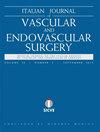Hospitalization rate and treatment strategy for critical limb ischemia in south Sardinia during COVID-19
IF 0.2
Q4 PERIPHERAL VASCULAR DISEASE
Italian Journal of Vascular and Endovascular Surgery
Pub Date : 2022-03-01
DOI:10.23736/s1824-4777.21.01527-8
引用次数: 0
Abstract
BACKGROUND: The year 2020 was characterized by COVID-19 pandemic with a consequent profound change in health systems and difficulties in accessing care for patients suffering from chronic diseases other than COVID-19, including critical limb ischemia (CH). The main purpose of this study was to verify whether the COVID-19 pandemic has led to a reduction in the hospital admission rate to the vascular surgeries of southern Sardinia and an increase in major amputations rate in patients suffering from CLI. METHODS: In our retrospective multicenter study, data of patients were analyzed using two different time frames for comparison: the year before Italian lockdown (P1) and the first year of pandemic (P2). Primary outcome was the rate of CLI-related hospitalization in the two period. Secondary outcomes were medical treatment, revascularization, and primary amputation rates. RESULTS: A total of 137 and 140 patients were admitted for CLI in the study centers during P1 and P2 respectively, with a comparable monthly hospitalization rate in the two periods (IRR 0.98;CI: 0.77-1.25;P=0.86). The median age was 76 years in P1 and 71 years in P2 (P=0.09);the two cohorts were comparable for demographical characteristics and risk factors. Patients treated medically in PI were 14% vs. 9% in P2 (P-0.298), 64% of patients underwent urgent revascularization in P1 vs. 70% in P2 (P=0.61) and 22% underwent primary amputation in P1 vs. 19% in P2 (P=0.58). CONCLUSIONS: Our study showed no significant differences in CLI-related hospitalization and in-hospital amputation rate between P1 and P2 in Southern Sardinia.南撒丁岛COVID-19期间重症肢体缺血住院率及治疗策略
背景:2020年的特点是新冠肺炎大流行,随之而来的是卫生系统的深刻变化,以及患有新冠肺炎以外慢性病(包括严重肢体缺血(CH))的患者难以获得护理。本研究的主要目的是验证新冠肺炎大流行是否导致撒丁岛南部血管手术的住院率下降,以及CLI患者的主要截肢率上升。方法:在我们的回顾性多中心研究中,使用两个不同的时间框架分析患者数据进行比较:意大利封锁前一年(P1)和疫情第一年(P2)。主要结果是两个时期CLI相关的住院率。次要结果是药物治疗、血运重建和原发性截肢率。结果:在P1和P2期间,研究中心共有137名和140名患者因CLI入院,两个时期的月住院率相当(IRR 0.98;CI:0.77-1.25;P=0.86)。P1和P2的中位年龄分别为76岁和71岁(P=0.09);两组人群的人口学特征和危险因素具有可比性。在P1接受药物治疗的患者为14%,P2为9%(P-0.298),在P1接受紧急血运重建的患者为64%,P2为70%(P=0.61),在P2接受原发性截肢的患者为22%,P2为19%(P=0.58)。结论:我们的研究显示,撒丁岛南部P1和P2在CLI相关住院和住院截肢率方面没有显著差异。
本文章由计算机程序翻译,如有差异,请以英文原文为准。
求助全文
约1分钟内获得全文
求助全文
来源期刊

Italian Journal of Vascular and Endovascular Surgery
PERIPHERAL VASCULAR DISEASE-
CiteScore
1.00
自引率
0.00%
发文量
27
审稿时长
>12 weeks
期刊介绍:
The Italian Journal of Vascular and Endovascular Surgery publishes scientific papers on vascular surgery. Manuscripts may be submitted in the form of editorials, original articles, review articles, case reports, therapeutical notes, special articles and letters to the Editor.
 求助内容:
求助内容: 应助结果提醒方式:
应助结果提醒方式:


